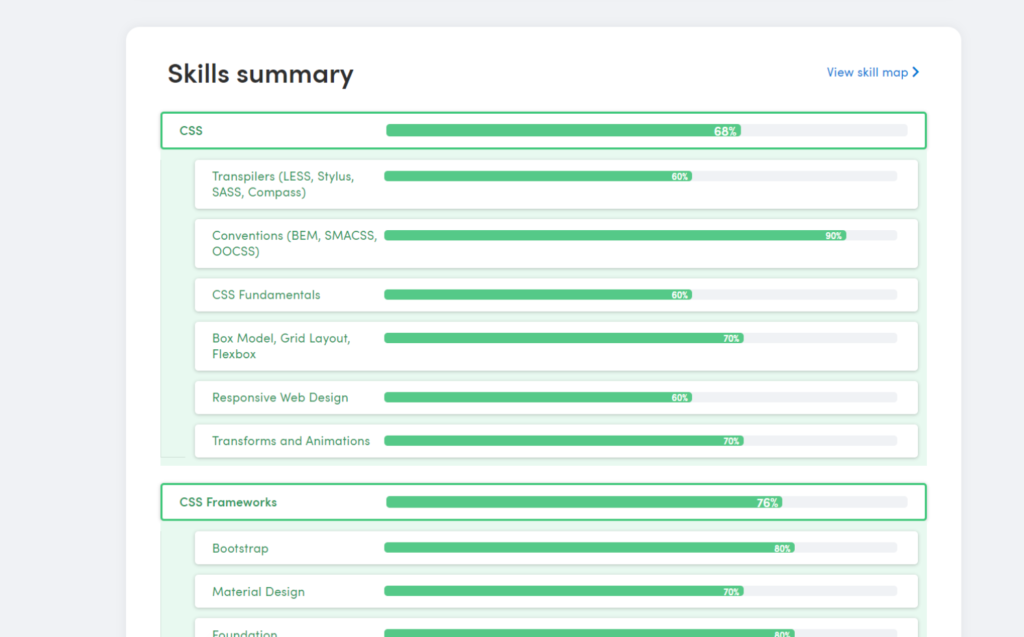
What is a skills matrix and why do you need it?

At least 133 million new roles are expected to be generated globally by 2022, and the rise in demand for technical skills such as software development will likely soar. From an IT recruiter’s perspective, this means one thing – you have to prepare yourself ahead of time and ensure that your team possesses the right skills. One way of making this happen is by creating an IT skills matrix.
What is a skills matrix?
An employee skills matrix is a visualization of skills and competencies that an organization currently has access to and the skills which are missing but will be required in the future. It also shows the level of proficiency of each employee for each skill.
For instance, let’s assume you run a software consultancy and would like to introduce Machine Learning into your offer within the next 12 months. By creating a competency matrix, you’ll be able to talk to each of your employees, map out all of their current skills, and establish how far your business is from achieving this goal.
As we discuss in detail further in this post, a skills matrix will allow you to create a realistic plan and decide whether you’re better off hiring new team members or focusing on employee training.
Job skills matrix – proficiency and interest
When you build your skills matrix, it’s critical that you evaluate two areas – proficiency and interest.
Proficiency is a clear indication of your team’s current abilities – i.e., how comfortable and knowledgeable each employee is with a given skill. Interest, on the other hand, is less tangible, but it indicates the extent to which your employee wishes to acquire a new skill or use one that they already possess.
If you find that your team is currently lacking an ability altogether, it’s your employees’ willingness to learn that will indicate how soon you’ll be able to reach your skills-related goals.
Fonte: Unsplash
Let’s now proceed and look at the reasons why you should conduct a skills matrix for your team.
6 Benefits of an IT skills matrix
Here are the top benefits of carefully assessing your team’s skills and motivation:
- Identifying current and future skill gaps
With a skills matrix in place, you’ll not only be able to evaluate skills on a cross-team level, but will also clearly see where you’re lacking the necessary expertise. This, in turn, will help you create a skills acquisition plan (which we discuss later in this post).
- Enhanced succession planning
The skills matrix gives you a bird’s eye view of what each employee brings to the table for your organization. This way, you’ll evaluate how much it would hurt your company skills levels if any of your employees were to leave. As a result, you’ll be able to create an ‘in-case-of-an-emergency’ scenario – i.e., plan ahead of time and decide whether you’d be able to fill the gap di competenze internally, or would have to hire a replacement.
- Progress monitoring
If you update your skills matrix regularly (which we highly recommend), you’ll be able to monitor your employees’ skills acquisition progress. This way, you’ll know whether sending your employees to training or hiring a junior developer to acquire new skills on the job had actually paid off.
- Identification of key players
There are A-players in every organization – do you know who they are? If you don’t, then creating a skills matrix is a great way to discover them – at an instant, you’ll know who has what skills and what their level of proficiency is.
Ideally, you wouldn’t like the most talented employees to leave your organization, as finding a replacement is costly and very time-consuming.
- Improved employee retention
Learning & Development is crucial for reducing employee turnover. In fact, according to a LinkedIn report, 94% of employees say they would stay in the same job longer if the company provided them with good learning opportunities.
Running a skills matrix will help you make sure that your employees continuously develop new skills, which will positively impact retention.
- Effectively assigning people to projects
Knowing what skills each employee has will help you manage your projects more effectively. After listing competencies required for each project, you’ll be able to quickly assign the right people to the right projects. This is especially beneficial for software houses.
How to create a skills matrix
There are two ways in which you can create your competency matrix – manually in an Excel/Google Spreadsheet, or by using a mapping tool. We’ll walk you through the steps of both techniques.
That being said, we recommend using the spreadsheet solution only as a starter method (or to monitor the skills of a very small team). If you’re planning to conduct regular skills assessments, you’ll save tons of time and effort by using a mapping tool like TalentBoost, which helps visualize your results, analyze the findings, monitor progress, and design potential career paths for employees.

Fonte: TalentBoost
How to create your skills matrix – a starter guide
Enough theory, it’s time for some practice. We’ll tell you step by step how to easily create a skills matrix.
Step 1. Create a list of all employees / Create employee profiles
For starters, you’ll need to list down all employees. If you’re using the spreadsheet method, create a column for each of your employees. If you’re using a talent management tool, start off by creating employee profiles. You don’t have to do this manually – if you use a tech screening platform, you can export all the names and upload them to your file or program.
Step 2. List the skills you need in your team
Next, make a list of all the skills you want to prioritize at your company. Make sure that the skills you write down align with the direction you want your company to go in. We advise that you double-check the list with a C-level executive before proceeding to step 3.
If you’re building your skills matrix in a spreadsheet, create a row for each of the desired skills.
If you’re using a talent management tool, start by building skill maps for all employees, and – once you’ve listed all the skills you need – evaluate who would take the fastest to acquire a given skill.
Step 3. Talk to your employees and their supervisors, pull data from tech screening platforms
Establish your employees’ current proficiency levels; this way, you’ll be able to spot employees who can either quickly acquire new skills or enhance their current proficiency levels. It can be done in numerous ways:
- Talk to your employees and ask them about their skills proficiency, maybe they didn’t disclose some of their skills during the interview or they managed to acquire new ones
- Conduct skills assessment to verify their current skill levels
- If you used a tech screening platform like DevSkiller during recruitment then you can pull out data from there. You can filter out employees based on the type of test they’ve taken and the score they’ve received. This should help you quickly identify all the skills that you have and at what level. It’s also a great method for spotting A-players.
Step 4. Analyze your findings and create a skills acquisition plan
Based on your findings from the knowledge matrix, you’ll be able to spot any skills gap and design a skills acquisition plan. It will also help you with creating career paths – maybe you have employees within your organization who could become team leaders? Or maybe some of your programmers could pick up another language?
Using a competency mapping solution like TalentBoost will let you easily visualize all the skills you have, identify any skills gaps, and track employee growth.

Fonte: TalentBoost
Skills matrix example
Check out the skills matrix template below to get a better understating of what it should look like and the elements it should incorporate.
You can download the template from here.
Summary
As you’ve just seen, a skills matrix will help you identify your team’s current skills, spot any skills gaps, and decide on a skills acquisition plan. You’ll be able to decide whether you’ll be best off by offering your employees training, or whether you’ll need to hire new team members.
There are plenty of benefits of creating and updating your skills matrix regularly. These include enhancing your succession plans, monitoring your employee’s career paths and training effectiveness, identifying key players, and assigning people to projects effectively.
By following the steps discussed in the article above, you’ll make sure that your company is always on top of strategic goals and offers services that ideally complement the market demand. While you can manage your skills assessment in a spreadsheet, we highly recommend that you give TalentBoost a try to speed up the entire process.
Image credit: Unsplash




